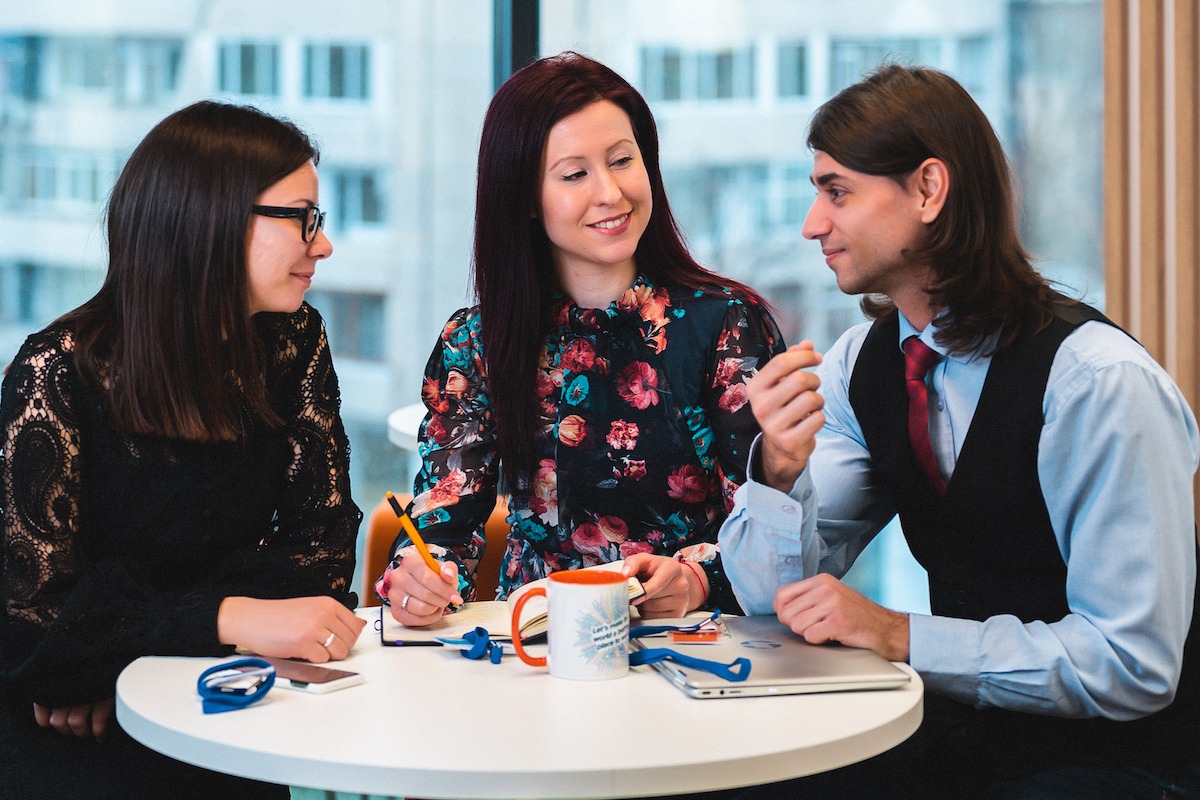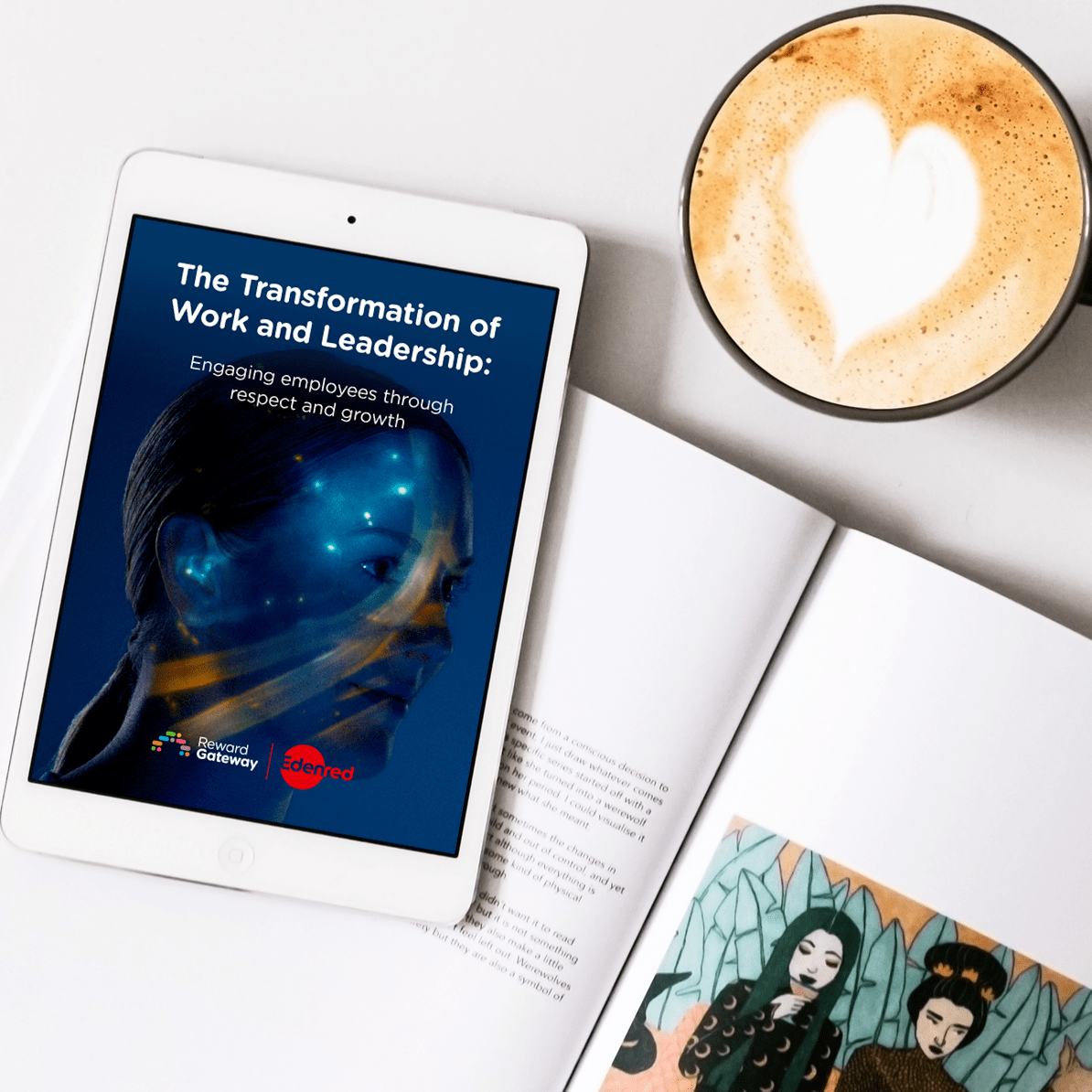Return to work, return to the office, return to "the new normal" - whatever it is that you may be calling it, many industries are undergoing changes as the world makes its way into post-pandemic day-to-day.
While your employees have undoubtedly been hard at work throughout this entire pandemic, any sort of change can be a bit jarring, and especially so if you have a lot of employees returning to the office when they may have gotten used to working from home for the past year and a half.
 As such, businesses that allowed their employees to work remotely (out of necessity) may be considering what the next right move is to welcome employees back to the new world of working. While some companies are embracing a fully remote working lifestyle, others are taking a hybrid approach, allowing employees the flexibility to come into the office part-time, and working from home when it makes sense.
As such, businesses that allowed their employees to work remotely (out of necessity) may be considering what the next right move is to welcome employees back to the new world of working. While some companies are embracing a fully remote working lifestyle, others are taking a hybrid approach, allowing employees the flexibility to come into the office part-time, and working from home when it makes sense.
Reward Gateway has always been a hybrid workplace, as we believe in flexible working, giving our employees the choice to work when and where they feel they can do their work the best.
That means that some of our employees have traditionally been in the office, others have come in a few days a week, and we have a very small number of permanently remote employees. I’ve spoken with a lot of companies who are struggling to define their different groups of employees, and how they can provide an optimal working environment for them, no matter where "work" might be. Here are a few tips from our own RG Work Modes Guide, which you can also access in full for free at the end of the blog:
How to define your new employee demographic
In 2016, we introduced RG Work Modes - our activity based model of where to work for the task you have at hand. With over 75 different activities powering our mission we found eight common themes that enable these activities to succeed and called these our Work Modes. These modes were created after team sessions where we researched, listened and spent a lot of time learning about our employees' existing work behaviors and habits. This was followed by the four year development and enhancement of our office spaces which would support these work modes and enable our employees to thrive.
When 2020 hit, all of those activities we’d described now needed to happen at home. Our whole company learned how to continue driving our mission forward and enabling these Work Modes to thrive in a new workspace, our homes.
 Our Group HR Director Rob Hicks says of the shift, “Reward Gateway was blessed with good fortune, having worked with Work Modes since 2016 with flexible working a core part of our EVP for over a decade. However over the last 18 months none of the new joiners have had the benefit of our workspace, and how we operate and use the space.
Our Group HR Director Rob Hicks says of the shift, “Reward Gateway was blessed with good fortune, having worked with Work Modes since 2016 with flexible working a core part of our EVP for over a decade. However over the last 18 months none of the new joiners have had the benefit of our workspace, and how we operate and use the space.
This means to make our space work, we need to ensure that everyone is aware of the values and benefits of using the space and also the best way to use them for maximum impact and value.
Our HR team was no different in working out how to tackle this challenge, educating our employees on our 2021 philosophy for hybrid working.
Adjusting our philosophy from 'never miss an important life event,' to 'never miss an important life or work event,' means that our employees can decide where to work. At times, this can mean coming to the office, so that the connection between employees and use of the space remains high, which is a great sign of employee engagement in action.”
Workspace correlates highly with engagement, which we know through its placement on our 10-step model to strategic employee engagement, The Engagement Bridge™. Changes to your workspace are proven to impact productivity, wellbeing, and engagement – both positively and negatively.
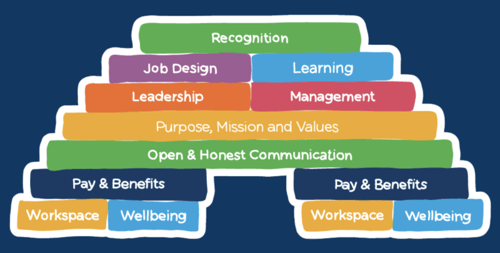
While some aspects of our work found this new environment of a fully remote lifestyle challenging and disruptive, other areas thrived. To support our employees’ newfound ways of working, we found ourselves with a deeper, more rounded understanding of how to truly make RG a better place to work by expanding our workspace to a hybrid of home, office and wherever our employees can best able to do the work they need to focus on at any time.
So we have two types of workers, Hybrid and Remote. Here’s how we define Hybrid Workers:
Hybrid Workers
 The definition of hybrid working, to us, means our people can work from wherever is most practical to do the work they need to get done, whether that’s the office, their home office or a coffee shop down the road.
The definition of hybrid working, to us, means our people can work from wherever is most practical to do the work they need to get done, whether that’s the office, their home office or a coffee shop down the road.
Hybrid Workers will have a main office assigned to them at the time of employment, and can liaise directly with their geo-specific experience manager for any office queries or needs. Our Hybrid Workers benefit from flexible working, and can request our Work from Home Desk Bundle to ensure they have the proper remote working environment, too as part of our employee benefits for remote employees.
Remote Workers
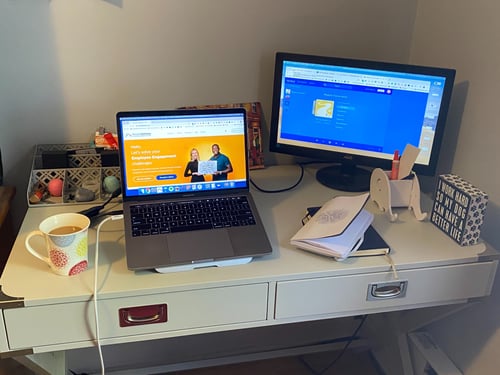 For our fully remote workers, these are very rare positions as we believe the majority of our roles work best where employees have a balance of virtual connection and face-to-face time with their teams.
For our fully remote workers, these are very rare positions as we believe the majority of our roles work best where employees have a balance of virtual connection and face-to-face time with their teams.
Remote roles are contractually decided by the business. Everyone who works remotely is also able to benefit from flexible working. These employees spend the majority of their time working remotely or visiting client sites and attending the office for important work events as required i.e. team kick off events, all-hands like boom!Fest or events brought to our clients and visitors in the Reward Gateway office (such as Engagement Excellence Live).
Define your work modes
For the last five years, Reward Gateway has been creating work environments that build culture, showcase Reward Gateway, connect people, enable success and support flexibility. In order to achieve our company goals and objectives, while also meeting the needs of our employees and engagement in our business, we must first understand how our people spend their time.
Work modes support your employees by:
| 1. Informing our ways of working norms and protocols for where to work and when. |
| 2. Ensuring that our employees do not have to feel lost or confused about where they should be working as we have mapped each Work Mode to our variety of workspaces designed to support the task they have at hand. |
| 3. Empowering our employees to tailor their Work Modes to their unique needs and personal preference. Everyone is different and our approach aims to respect and acknowledge that. |
What are work modes?
 RG Work Modes describe the key activities that make us productive, collaborative and happy. Our Work Modes support and align with our eight core values, and inform us how our workspace, whether office or home can be used most effectively.
RG Work Modes describe the key activities that make us productive, collaborative and happy. Our Work Modes support and align with our eight core values, and inform us how our workspace, whether office or home can be used most effectively.
Our Work Modes were developed with our employees who discussed the activities that go into their role, why each activity is important and what environment best supports it. They recognize the unique nature of each of our employees and allow them to embrace however extroverted or introverted they may be feeling at any time in any place.
Our Work Modes include:
- Retreat
- Plugged In
- One-to-One
- Little
- Large
- Buzzin’
- Briefing
- #RGfun
The time working from home in 2020 was a great opportunity for us to fully understand our Work Modes as they were put to the test in the home environment. Our learnings enabled us to evolve our Work Modes model ready for Reward Gateway's global office reopening (per geo-guidelines) this month.
In his latest Mission Monday leadership blog, our CEO Doug Butler coined our new philosophy to how we’ll approach work, which is ‘Safely, Together is Better,’ a nod to our hybrid model and how we’ll balance an in-person working style with working from home.
Here’s a closer look at what a potential return to work plan can look like in action:
How to define home working styles
Our recommendations for "Home" Work Modes mean you can be highly effective in tasks that require you to work in this way without having to be in the office.
Our employees are still welcome to use the office space to work in this way and we have areas designed to enable these Work Modes in the office, but we feel they are most effective when done outside of the office.
Reward Gateway benefits as it means less demand for smaller meeting spaces in the office. Providing this level of flexibility is also a great way to attract candidates to work for us and provides our current employees with a work/life balance they really benefit from.
Proactive calendar management means employees can design their week so that tasks that need this kind of Work Mode can all be aligned to when they work away from the office.
You’ll see that we broke out this table in ways that we hope will be easy for our employees to relate to, in terms of how they want to feel at the end of their session, what they need from this work mode, how it connects to our eight company values, and how they can "design" their workspace for the best success.
Recommended "Home" working model"
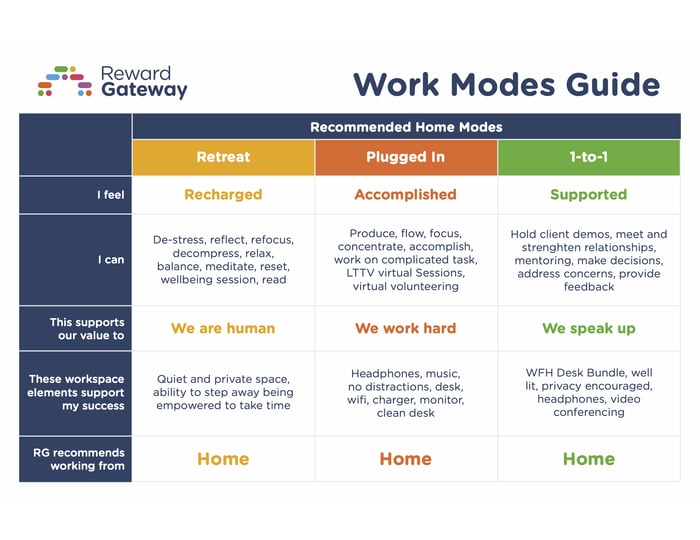
Recommended "Office" working model
Working from home for over a year allowed us to assess what the office space truly succeeds at. As a global business with teams operating in different locations some of these work modes will need to be delivered in a digital format and though we managed to adapt to a digital alternative for every Work Mode during that period, there are some modes of work which we feel are best done in the office.
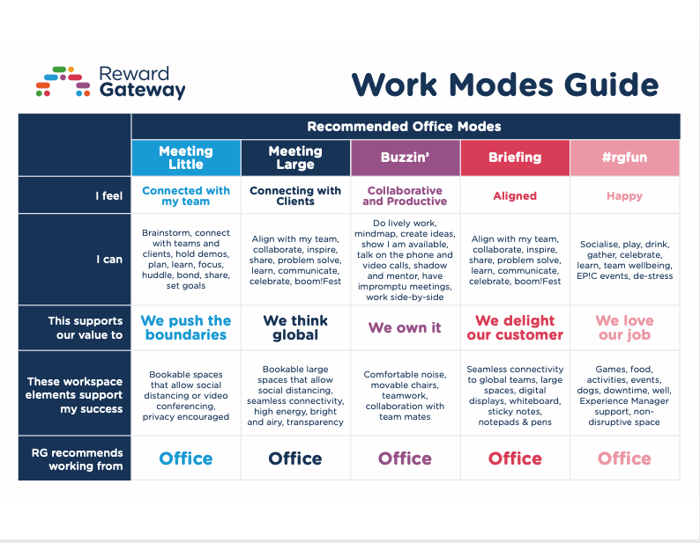
These are a sampling of our own Work Modes, but it’s important to note that each and every business will have their own version of Work Modes that align with how their people do their best work, and connected to each company’s own values and purpose.
We’re just starting out with our return to the office, and will be collecting feedback from our employees to see if we can or should adjust any of these Work Modes to continue to enhance and develop our ways of working at RG.
If you’d like to take a look at our own Work Modes Guide to see how they differ within each of our offices, feel free to take a browse.
Read the Return to Work Guide »
For me, I'll consider our Work Modes a true success when I hear our employees regularly referring to these modes in conversation, such as "I’ll be having a Plugged In session for the upcoming LTTV, so I won’t be in the office." Stay tuned for another blog on how we plan to measure the success of naming Work Modes through employee surveys and strategic communications.

 Catrin Lewis
Catrin Lewis
